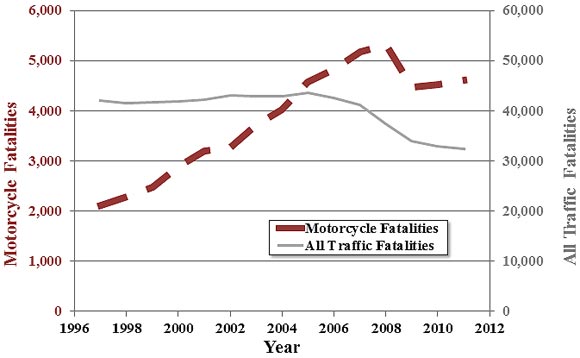
Over $75 million in verdicts and settlements in 18 years.
Motorcycle Accident Causation Study
Motorcycle Accident Research For Motorcycle Safety
In 2009 Motorcyce Crash Related Fatalities Were Twice Auto Crash Fatalities
The safety of motorcyclists on our nation's roads has become an increasing concern among traffic safety professionals.
In 2009, there were 4,462 motorcycle crash-related fatalities in the United States—more than twice the number of motorcycle rider fatalities that occurred in 1997. This increase contrasts with a 27-percent reduction in the number of fatalities in passenger cars and light trucks. In response to this growing concern, the U.S. Congress passed legislation to fund a Federal Highway Administration (FHWA) research effort into the causes of motorcycle crashes in the United States.

There has been no Department Of Transportation (DOT) sponsored comprehensive study in the United States of motorcycle crashes for over 30 years. And things have changed.
In the new pilot study, nearly 20% of the riders were wearing some sort of armor as motorcycle safety gear, a new attribute under clothing type.
In my experience most motorcycle riders are very safe and cautious, because they know their lives are on the line.
In fact, the last comprehensive study (Hurt in 1981) of motorcycle crash statistics in the USA indicated that in 3/4 of multi-vehicle crashes, most often car vs. motorcycle, it was the car that impeded the motorcycle's right of way and caused the accident.
It's only gotten more dangerous for motorcyclists.
According to the National Highway Transportation Safety Administration (NHTSA), “Per vehicle mile traveled in 2006, motorcyclists were about 35 times more likely than passenger car occupants to die in a motor vehicle traffic crash and 8 times more likely to be injured.” In 2004, motorcyclist fatalities were 77% higher than motorcyclist fatalities in 1994. Yet in this same time period, passenger car vehicle fatalities were on a steady decline of 22%.
In 2005 Congress recognized the disturbing trend in rising motorcycle fatalities and authorized $2.8 million grant for a comprehensive motorcycle crash study. The terms of the Federal money require that this $2.8 million Federal grant be matched with equal funds from the motorcycle industry. A comprehensive motorcycle crash study like this has not been done for nearly 30 years.
The American Motorcyclist Association (AMA) created the, “Fueling the Fund,” to help motorcycle riders themselves to get involved in raising this money either by making donations through the AMA or by helping spread the word. The pilot study will be complete in 2016.
AMA members contributed money to help pay for the study, and the AMA encouraged states to redirect unused federal funds to the effort. Supporting the study are the Federal Highway Administration, the National Highway Traffic Safety Administration and the states of Iowa, New Mexico, New York, Ohio, Oklahoma, Texas and Wisconsin.
You can read more about this at the AMA website.
Data from a comprehensive motorcycle crash study can teach us much about how to prevent being involved in a motorcycle accident. This is especially important to learn now as Consumer Reports says that more and more Americans turn to mopeds and motorcycles to cope with rising gas costs and rising costs of everything.
Data that the National Highway Transportation Safety Administration (NHTSA) has already compiled provide us with much information of actions we as motorcyclists can do to prevent being one of these motorcycle crash statistics.
Of course, not all accidents are avoidable, but the data from the last comprehensive motorcycle study, the one from 1981 often referred to as the Hurt Study, and the NHTSA and DOT data are quite empowering and tell us:
Wear a helmet.
Don't drink alcohol and ride.
Wear eye protection. Data shows us that 73% of motorcycle riders in accidents were not wearing eye protection.
Use a helmet light in daytime and wear bright yellow or orange colors – this has been shown to make a significant difference in motorcycle accident occurrence; in other words, be visible.
In fact, the failure of motorists to see the motorcycle in traffic is the predominant cause of motorcycle accidents. The Hurt Study said that in three fourths of motorcycle accidents involved in a collision with another vehicle, usually a passenger car, it was found that the driver of the car violated the motorcycle's right of way. In the majority of multi-vehicle motorcycle vs. car crashes, the car driver didn't see the motorcycle at all or at least until it was too late to do anything to avoid the accident. It follows then that the most common accident scenario and trouble spot is intersections with the motorcycle heading straight and an oncoming car turning left in front of the oncoming motorcycle.
A motorcycle accident typically gives the motorcycle rider less than two seconds to complete all accident avoidance maneuvers. However, motorcyclists involved in studied motorcycle crashes had poor accident avoidance skill. Motorcycle accidents commonly show problems with steering and braking.
The motorcycle crash study data that we do have available at this time tells us that motorcycle safety education and being experienced on your motorcycle is of a huge importance. I am a big believer in motorcycle safety training and in the past I offered a free PSSR track day with every motorcycle case I handled (until the motorcycle instructors at PSSR retired). Motorcycle safety training is vital training and experience with your motorcycle in a non traffic environment where you can push your skills to improve and really get to know your motorcycle. Motorcycle crash study data that we do have tell us us that most motorcycle riders involved in accidents were inexperienced. When we look at this compared to the fact the known data also shows us that street motorcycle riders with dirt bike riding experience are underrepresented in motorcycle crash data.
If you are interested in learning more from these motorcycle crash studies, here are some resources:
- The Hurt Study, funded by the NHTSA, was the last comprehensive motorcycle crash studied performed in the USA back in 1981. You can order the complete report by contacting
National Technical Information Service
5285 Port Royal Road
Springfield, Virginia 22161
(703)-487-4600
With the following order information:
Motorcycle Accident Cause Factors and Identification of Countermeasures, Volume 1: Technical Report, Hurt, H.H., Ouellet, J.V. and Thom, D.R., Traffic Safety Center, University of Southern California, Los Angeles, California 90007, Contract No. DOT HS-5- 01160, January 1981 (Final Report)
Vol.I (The Main Report and Summary) is PB81206443 (~400 pages)
Vol.II (Appendix: Supplementary Data) is PB81206450 (~400 pages)
Either document is $42.95 plus $3.00 shipping. (circa 1990) - Motorcycle Crash Causation Study
- Federal Register Summary Motorcycle Crash Causation Study and Pilot Motorcycle Crash Causes and Outcomes Study (PDF)
- Motorcycle Crash Causation Study - Links (includes historic like Hurt Study)
- Motorcycle Safety Foundation, Research in Motorcycle Crashes
- NHTSA Guideline Motorcycle Safety (PDF)


